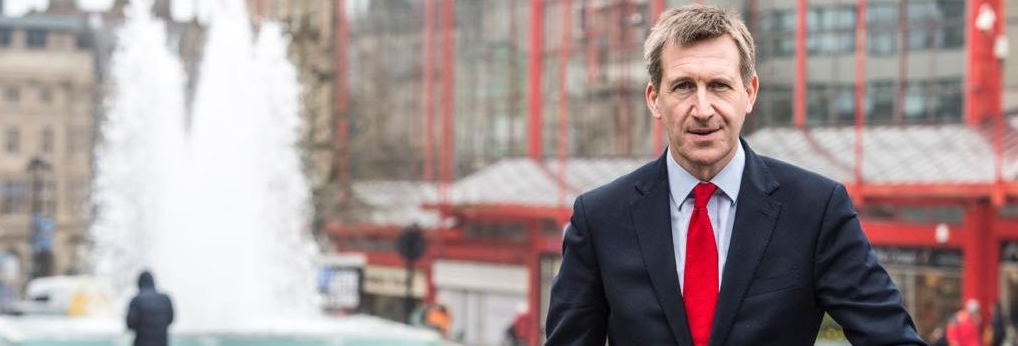
‘CLAWING BACK FUNDS TO WHITEHALL’: MAYOR DEMANDS GOVERNMENT RETHINK AS REGIONAL FUNDS CUT
Published 15 January 2021 at 3:09pm
Sheffield City Region Mayor Dan Jarvis has called on Ministers to urgently recommit to a devolved approach to levelling up the North, as new figures showed key regional development funds designed to support local investment priorities being replaced by smaller pots of money with significant control shifted back to Whitehall.
The Government’s Spending Review announced replacements for two key regional development funds, the Local Growth Fund (LGF) and the European Union Structural and Investment Funds. However, the figures showed:
- The Local Growth Fund, which expires in March, was worth an average of about £1.5bn a year, and will be replaced by a Levelling Up Fund (LUF) worth an average of £1.3bn a year over the next four years. For 2021, the LUF will be worth just £600m.
- EU funds will be replaced by the Shared Prosperity Fund (SPF). Ministers have only committed to it eventually matching current EU support – also some £1.5bn a year on average. But the time it will take to reach that level is unclear, and in 2021 just £220m of SPF funds will be allocated. EU funds had also been due to sharply increase this year – but there is no indication that rise that will be reflected in the SPF.
- That means that in 2021 regional development spending through the SPF and LUF will be just £820m, compared to the £3bn average from EU funds and the LGF.
While there will be an increase in infrastructure spending at a national level, is not yet clear how much will be targeted at the most deprived areas. The bulk of the higher spending will be under centralised control, and reflect centralised priorities.
The Mayor also raised a serious concern about control of the remaining dedicated regional development funds. LGF money was spent through the Local Enterprise Partnerships and Mayoral Combined Authorities, but the LUF is a common fund, where local authorities will have to compete against each other for limited, one-off pots of cash. The funds can only be spent on infrastructure projects, and only up to a maximum of £20m – excluding other key measures to boost local economies like business support initiatives.
Both EU and LGF funds have previously been used to support South Yorkshire’s economic turnaround, revitalising its towns and unlocking private sector investment from world-leading companies such as McLaren and Boeing.
Mayor Jarvis called on government to use the upcoming budget, due to be published in March, to replenish both funds to their previous levels as a minimum, and to devolve control and end restrictions so regional leaders can support their local economies according to local priorities – and not just with infrastructure spending.
Dan Jarvis, Mayor of the Sheffield City Region, said:
“The Spending Review promised to boost devolution but has cut these critical funds designed to support local priorities for economic development. The new Levelling Up Fund will be run by Westminster, with restrictions that make it much harder for regions to attract and nurture growing businesses. This threatens to undermine our efforts to deliver economic recovery and renewal for people across the North, and calls the government’s commitment to devolution into question.
“Rather than letting local communities take back control, money and powers are being sucked back to Whitehall, into fragmented, opaque mechanisms which pit region against region and reverse the devolution the government says it supports. This is not how we address the decades of centralisation and chronic underinvestment holding back the potential and prosperity of the North. They must change course at the Budget.”
Notes to consider
- Our comparisons are based on the dates funds were allocated, the average annual figures for the LGF and EU funds, with adjustments for inflation. Further details are available on request.
- The Levelling Up Fund has been only allocated £600m in 2021/22, just 40% of the £1.5 billion average annual spend under the Local Growth Fund. The LGF was worth a little over £9bn over the six years from 2015 to 2021, while the LUF is £4bn for the four remaining years of the current parliament. (Both figures relate to funding for England only.)
- South Yorkshire previously received around £60m per year LGF funding, which was spent according to local economic priorities. Under the LUF, the region will compete against other places for piecemeal pots of £20m, on a case by case basis. The restriction of the funds to infrastructure means places like South Yorkshire have no funding to attract businesses to invest in the region – stifling its ability to grow and attract jobs in the fightback from COVID.
- The Government previously committed to at least match the £1.5 billion per year EU funding through its Shared Prosperity Fund, but the Spending Review only brought forward a £220m pilot in 2021/22. The government has made no commitment to match future increases in EU development funds UK regions would have been eligible for – including the very substantial increase several Northern areas would have seen from 2021. EU spending for South Yorkshire was projected to go from €117 per person in 2014-2020 to €500 in 2021-27 – an increase from about €169m to €700m in total. If the UK government only replaces previous EU funding (and it is not yet clear that regional allocations will stay the same), the loss for South Yorkshire would be €531m (about £460m), or £77m a year.
- The £900m Getting Building Fund was put in place as an emergency measure in August 2020, with Local Enterprise Partnerships (LEPs) given about a week to submit ‘shovel ready’ infrastructure schemes. There is no indication any new allocation is planned in 2021, although spending will continue.
- The £3.6bn Towns Fund was announced before the 2019 election but will allocate £621m in 2021/22. The Future High Streets Fund was first announced in 2018, but disbursements were announced at the end of 2020. The initial fund was worth £675m, with an additional £325m later transferred from the Towns Fund.
- If we include all £675m of new funding from the future High Streets Fund and the £621m from the Towns Fund along with the £820m EU and LUF funds, the total is £2.1bn, compared to around £3bn for the LGF and EU funds.
INFO & SHARE
Last Updated: 16/11/2023
Published In: Governance , Business and Growth , Mayor , Finances
The latest news...
To find all of our press releases and news stories visit our dedicated news section



